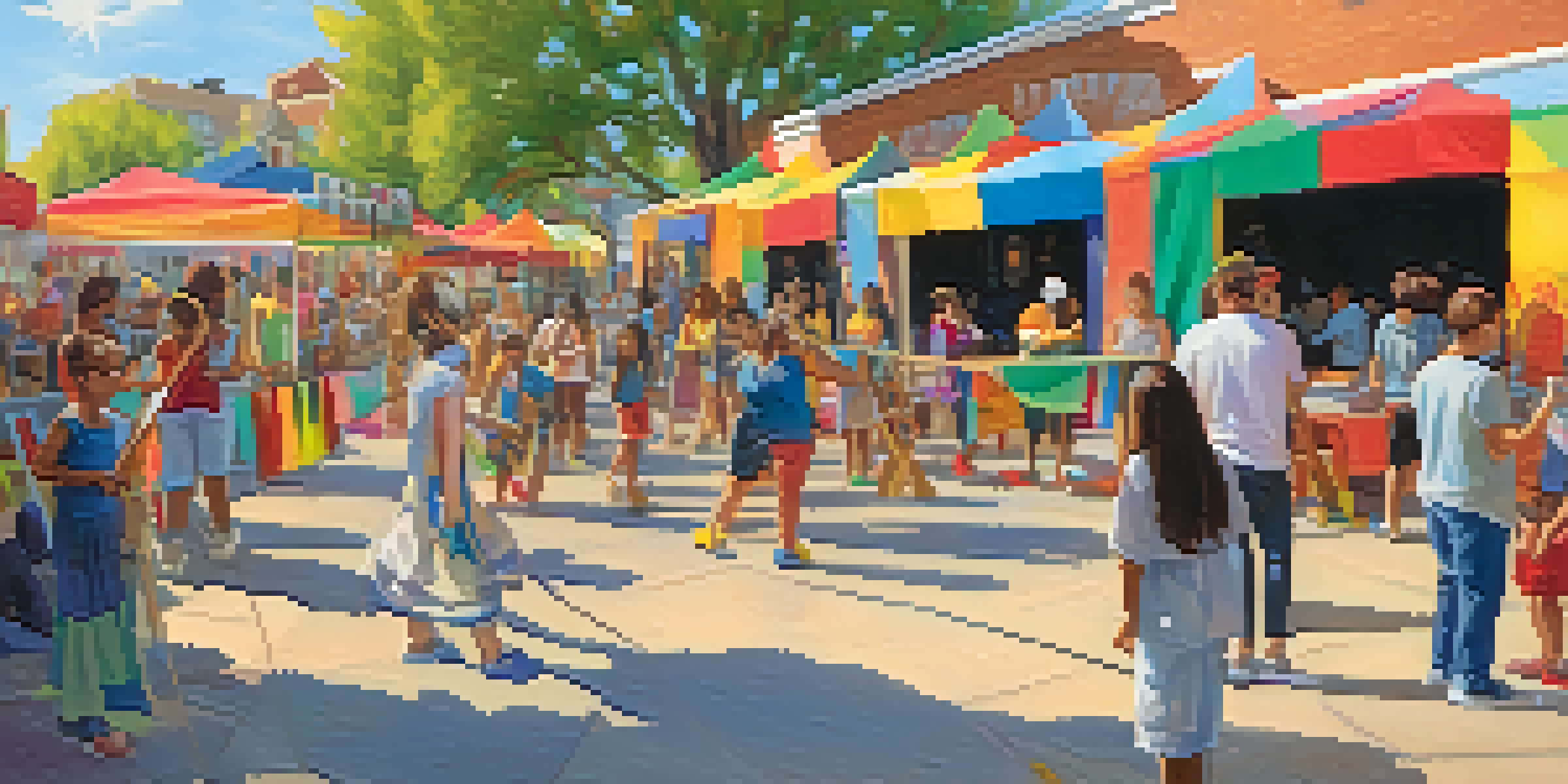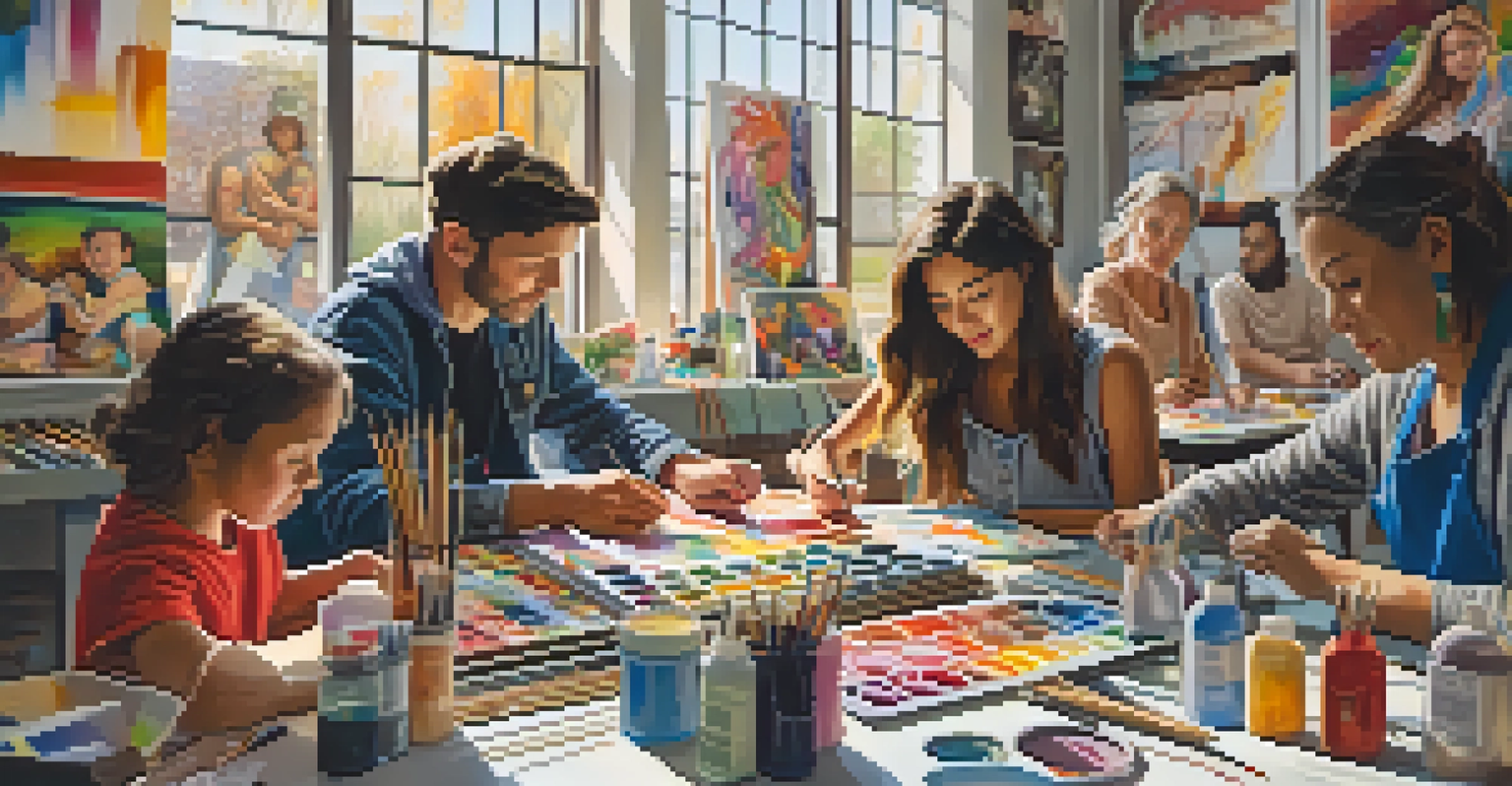The Impact of Arts on Community Engagement and Culture

Art as a Catalyst for Community Connection
Art has a unique ability to bring people together, fostering connections and encouraging dialogue. Community events centered around art, such as festivals and exhibitions, create spaces where individuals can interact, share experiences, and form relationships. These gatherings often spark conversations that might not occur in everyday life, bridging gaps between diverse groups.
Art is a universal language that speaks to the soul and connects us all.
By participating in artistic activities, people from various backgrounds unite to celebrate creativity and expression. This collaboration not only enriches personal relationships but also strengthens community ties. For instance, local art projects can engage youth and older generations alike, creating a shared sense of purpose and belonging.
Moreover, art can act as a mirror reflecting community identity, allowing residents to explore and express their shared history and values. This sense of unity fosters pride within the community, encouraging deeper engagement and participation in local initiatives.
Enhancing Cultural Identity Through Artistic Expression
Cultural identity is often shaped through artistic expression, which serves as a medium for storytelling and heritage preservation. Local artists frequently draw inspiration from their cultural backgrounds, creating works that resonate with their communities and celebrate their unique narratives. This not only keeps cultural traditions alive but also educates others about diverse experiences.

Art can be a powerful tool for cultural exchange, allowing communities to share their stories with wider audiences. For example, cultural festivals that showcase traditional music, dance, and visual arts encourage appreciation and understanding among different groups. This exchange fosters respect and empathy, essential for peaceful coexistence.
Art Unites Communities Through Connection
Art fosters connections and dialogue among individuals, bridging diverse groups and enhancing community bonds.
Additionally, the visibility of diverse artistic expressions promotes inclusivity and representation. When community members see their cultures reflected in local art, it validates their experiences and encourages them to engage more with their surroundings, leading to a richer, more vibrant community.
Art Initiatives as Platforms for Social Change
Art initiatives often serve as platforms for addressing social issues, raising awareness, and advocating for change. Artists can highlight pressing community concerns through their work, prompting discussions that lead to action. For instance, murals addressing topics like climate change or social justice can inspire community members to get involved and make a difference.
The role of the artist is to ask questions, not to answer them.
Community-based art projects often invite participation from residents, empowering them to share their stories and perspectives. This participatory approach not only enhances the visibility of local issues but also fosters a sense of ownership among participants. By collaborating on art projects, community members can rally around common goals and create unified movements for change.
Moreover, art can transcend language barriers, making it an effective tool for communication in diverse communities. Through visual art, music, or performance, artists can convey complex messages that resonate with a wide audience, encouraging deeper engagement and understanding of social issues.
Accessibility of Art and Its Role in Community Cohesion
Making art accessible to all community members is crucial for fostering engagement and cohesion. When art programs are offered in public spaces, such as parks or community centers, they invite participation from people of all ages and backgrounds. This accessibility allows everyone to experience and contribute to the local arts scene, promoting inclusiveness.
Community workshops and classes can help demystify artistic practices, encouraging individuals who may not consider themselves 'artists' to explore their creativity. This process of discovery can lead to enhanced self-esteem and personal expression, enriching the community's cultural fabric. When people feel empowered to engage with art, they are more likely to participate in other community activities.
Cultural Identity is Expressed Through Art
Art serves as a medium for storytelling and cultural preservation, allowing communities to celebrate their unique narratives.
Furthermore, accessible art initiatives can stimulate local economies by attracting visitors and fostering collaboration among local businesses. When communities prioritize the arts, they create vibrant, attractive environments where residents and visitors alike can connect, learn, and grow.
The Role of Technology in Arts and Community Engagement
In today's digital age, technology plays a significant role in enhancing community engagement through the arts. Online platforms allow artists to share their work with wider audiences, creating virtual spaces for interaction and collaboration. This expanded reach encourages participation from individuals who may not have physical access to local art events.
Social media has become a vital tool for promoting community arts initiatives, enabling organizers to reach diverse audiences quickly. By sharing stories, videos, and images of artistic endeavors, communities can rally support and inspire participation. This digital presence can help build a sense of belonging, even among those who may be geographically distant.
Moreover, technology can facilitate virtual art workshops and collaborative projects, breaking down barriers to participation. These innovative approaches ensure that art remains a dynamic, inclusive force for community engagement, adapting to the changing needs and preferences of residents.
Art Education and Its Impact on Community Development
Art education plays a crucial role in community development by nurturing creativity and critical thinking skills. Programs in schools and community centers can empower individuals, helping them to express themselves and develop their talents. This foundation not only enriches personal lives but also contributes to a more innovative and adaptable community.
Engaging youth in art education can lead to positive long-term outcomes, including improved academic performance and increased civic involvement. When young people are encouraged to explore their creativity, they often develop a greater sense of empathy and understanding towards others. These skills can translate into active participation in community life, fostering a culture of collaboration.
Accessibility Fuels Community Engagement
Making art accessible encourages participation from all community members, enriching local culture and fostering inclusivity.
Furthermore, art education can attract families and individuals to a community, enhancing its appeal and vitality. A community that values and invests in the arts is often viewed as progressive and inclusive, drawing in diverse populations eager to contribute to and benefit from a thriving cultural scene.
Celebrating Diversity Through Community Arts Programs
Diversity is one of the most enriching aspects of any community, and arts programs can celebrate this through inclusive representation. By showcasing the work of artists from various backgrounds, communities can highlight the richness of their cultural tapestry. This celebration fosters a sense of belonging and encourages individuals to share their unique perspectives.
Community arts initiatives often provide platforms for underrepresented voices, allowing them to share their stories and experiences. This not only empowers artists but also educates the broader community, fostering understanding and appreciation of different cultures. For example, storytelling events or multicultural art exhibitions can create spaces for dialogue and connection.

Ultimately, by promoting diversity through the arts, communities can cultivate an environment of respect and collaboration. This inclusion strengthens community bonds and creates a sense of pride, transforming the local landscape into a vibrant mosaic of cultures and ideas.